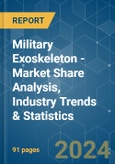The Military Exoskeleton Market size is estimated at USD 166.97 million in 2024, and is expected to reach USD 315.62 million by 2029, growing at a CAGR of 13.58% during the forecast period (2024-2029).
For instance, in February 2021, Sarcos Robotics and the Paramount Group signed a memorandum of understanding (MoU) to expand Sarcos' sales of defense exoskeleton technology to government and industrial customers in the Middle East and Africa. The companies are also investing robustly in new-generation, lightweight exoskeletons integrated with advanced sensors to enhance the overall situational awareness of dismounted soldiers. Such investments are expected to help the companies enhance their footprints in the market in the coming years.
This product will be delivered within 2 business days.
Key Highlights
- Despite the impact of the COVID-19 pandemic on global economies, the market for military exoskeletons was negligibly impacted as the investments in emerging technologies remained unaffected.
- Technological advancements in modern warfare are the major driving factors for the military exoskeleton market. Efforts are being made to further increase the efficiency of military exoskeletons through the incorporation of new technologies, which are expected to further propel the growth of the market in the years to come.
- The focus on increasing the safety and efficiency of dismounted soldiers has led to the military investing in these technologies, as exoskeletons reduce the fatigue of soldiers while also giving them an extra layer of protection from the outside.
- Despite all the advantages that exoskeletons offer, the main hindrance to their adoption is the high purchase costs involved. Efforts are now being made to further reduce the manufacturing costs of these exoskeletons.
Military Exoskeleton Market Trends
The Active Exoskeleton Segment is Expected to Witness the Highest Growth During the Forecast Period
- The active exoskeleton segment is projected to show remarkable growth during the forecast period. An active or powered exoskeleton is an electromechanical robotic device composed of electric motors, batteries, body structure, actuators, hydraulics, and joints, among others. Active robotic exoskeletons are utilized for improving efficiency by providing rehabilitation of stroke or spinal cord injury, improved strength, and endurance, thereby increasing the productivity of military people in high-risk areas.
- Currently, active robotic exoskeletons have limitations such as the inefficient source of power supply, the high cost of designing the skeleton (body structure), the inefficiency of actuators, and lesser flexibility. Active robotic exoskeletons do not support much special movement, making it difficult to exactly match the body part motions.
- Also, most actuators utilized in powered robotic exoskeletons are standard hydraulic cylinders, which are precise and powerful but very heavy and expensive. Thus, there is a need for a lightweight and flexible actuator design. Many prominent players in the market have been involved in the launches and developments of new active or powered exoskeletons.
- For instance, Bionik Laboratories Corporation, Hocoma AG, Myomo Inc, and ATOUN Inc. launched and enhanced their products in the active wearable exoskeleton market in the recent past. Such robust investments in the development of active exoskeletons are anticipated to accelerate the growth of this segment during the forecast period.
North America is Anticipated to Register the Highest CAGR During the Forecast Period
- The North American region is anticipated to witness the highest growth in the military exoskeleton market due to the high purchasing capacity of the United States and the presence of many manufacturers in the country.
- The country is investing huge amounts in the research, development, and testing of exoskeletons. As of mid-2021, the US Army was testing out a pair of powered exoskeleton boots called the Dephy ExoBoot, which could soon allow soldiers to easily carry heavily loaded rucksacks over long distances.
- Similarly, Lockheed Martin's ONYX, a powered lower-body exoskeleton, has demonstrated its ability to increase mobility and reduce the fatigue of military personnel in the trials conducted by the US military. These exoskeletons are also expected to be inducted in large quantities during the forecast period.
- On the other hand, Canada has been heavily investing in its soldier modernization program, the Integrated Soldier System Project (ISSP). The project's focus has been to provide its soldiers with the best equipment and wearables for all kinds of warfare. Canadian soldiers used the Trojan Ballistics Suit of Armour, which is believed to be the first ballistics exoskeleton body suit of armor. Such investments in the modernization of military equipment for dismounted soldiers are expected to drive the growth of the market in the coming years.
Military Exoskeleton Industry Overview
The military exoskeleton market is fragmented, with many global and regional players (OEMs, Tier 1 suppliers, and R&D centers) providing full-body and partial-body exoskeletons to the armed forces and government agencies. Some of the prominent players in the market are Lockheed Martin Corporation, SRI International, Sarcos Technology and Robotics Corporation, Robotics Corporation, ASELSAN AS, and Dephy Inc. To enhance their sales and geographical presence, the companies are partnering with regional defense manufacturers and governments.For instance, in February 2021, Sarcos Robotics and the Paramount Group signed a memorandum of understanding (MoU) to expand Sarcos' sales of defense exoskeleton technology to government and industrial customers in the Middle East and Africa. The companies are also investing robustly in new-generation, lightweight exoskeletons integrated with advanced sensors to enhance the overall situational awareness of dismounted soldiers. Such investments are expected to help the companies enhance their footprints in the market in the coming years.
Additional Benefits:
- The market estimate (ME) sheet in Excel format
- 3 months of analyst support
This product will be delivered within 2 business days.
Table of Contents
1 INTRODUCTION
4 MARKET DYNAMICS
5 MARKET SEGMENTATION
6 COMPETITIVE LANDSCAPE
Companies Mentioned (Partial List)
A selection of companies mentioned in this report includes, but is not limited to:
- Lockheed Martin Corporation
- Sarcos Technology and Robotics Corporation
- Rostec
- Safran SA
- BAE Systems PLC
- Dephy Inc.
- Aselsan AS
- Bionic Power Inc.
- Mawashi Science & Technology
- SRI International
Methodology

LOADING...










